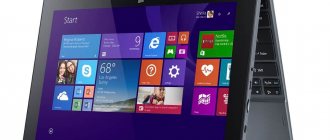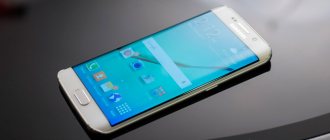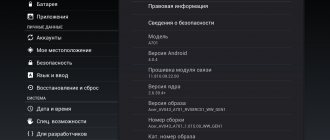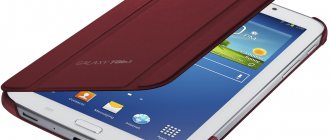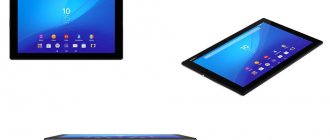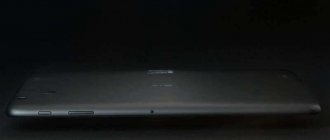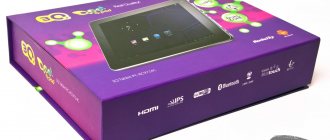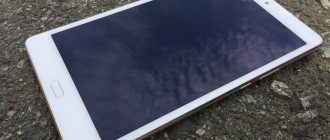Almost all owners of the Xiaomi MiPad 2 tablet PC from the Russian-speaking region have to be puzzled by the issue of updating their device’s firmware at least once during the operation of the model. The material below presents several ways in which you can bring the software part of the tablet in accordance with the requirements of most users. And also, if necessary, the following will help eliminate the consequences of errors when operating the device, installing the OS, restoring the functionality of the system software on the device, and transitioning from Android to Windows and back.
Indeed, the generally excellent product MiPad 2 from the famous manufacturer Xiaomi may upset the consumer with the work and functionality of the system software preinstalled by the manufacturer or seller. There are no Global firmware for the model, since the product is intended for sale exclusively in China, and the interface of the China versions does not have Russian language, and there is no support for many of the services we are familiar with.
With all of the above, it’s definitely not worth despairing and tolerating the shortcomings of Chinese versions of MIUI or firmware bugs installed by someone unknown! By following the instructions below, you can get an almost ideal solution for work and entertainment with all the necessary functions and capabilities. Just don't forget:
Before proceeding with manipulations with the system software of the device, the user is fully aware of the risks and possible negative consequences for the device, and also assumes full responsibility for the results of the operations!
Purchase history
I received a request to choose a decent tablet... Device requirements: retina screen, high-quality front camera, 7.9 inches diagonal. Several models fit diagonally: a pair of telecasts, an i5 and a mipad1. It was decided to take the white mipad1 (the price was the cheapest)
While we were thinking, they were over. We chose yellow and unexpectedly (for me) mipad2 appeared. I suggested it. www.gearbest.com had the best pre-order price. I placed an order, paid and waited. PayPal
They gave me the tracking number XF—CN. "RUSSIA Express" service. I put it in the tracker and began to wait.
Suddenly the courier called me and said the package had arrived. I racked my brain to find out what was there. After opening the package, I was very happy to see the tablet.
I ordered the tablet on my own terms: after receiving it, I review it and then give it to the owner. I, in turn, spent 27$ Gb Points. Win-win deal
Equipment
On the front surface there is a render of the front part of the tablet + the back part of two possible colors.
On the sides of the box there is a modest inscription Mipad2 in Chinese
On the reverse side in the lower left corner is a sticker with performance characteristics, serial number and production date.
The box is very compact.
Everything is done wisely: there is a cutout for the keys.
Under the tablet there is a bed with charging and a USB cable.
The charger is very miniature. Glossy plastic is covered with transport film.
Its size is 4x3x2 cm. The USB output is neatly covered with a sticker.
Small, but daring! Can output up to 2 amps.
The USB cable is in a separate bag.
He's a new generation, sir.
The length is 1m 20cm. The cable is soft and tactilely pleasant.
Appearance.
Gold tablet.
There are no sharp corners, all edges of the tablet are smoothed.
The device is not collapsible. The tablet is very comfortable to hold in your hand. There is a matte shipping film on the screen, I did not remove it. In the upper left corner is the Xiaomi logo: MI.
In the center of the top of the tablet there is a light sensor and a front camera.
On the right is an RGB event indicator.
The headphone jack is located at the top and is strongly shifted to the left.
At the bottom there are backlit touch buttons. Under them there is a USB connector, type C.
On the right side are the volume and power keys.
The keys are shifted slightly downwards. The lowest one is the power button and you don’t need to reach for it.
In the right corner is the main camera.
The lens is carefully sealed. There is a microphone hole nearby. At the top of the cover along the axis of the tablet there is a second hole for the microphone.
In the metal cover at the bottom edge there are two perforation zones under which two stereo speakers are hidden.
The designers strived for symmetry and they did it very well, as did the programmers. Screen
Screen resolution 2048 x 1536, diagonal 7.9 inches, PPI 326.
Of course, I’m already used to retina on the 9.7 inch Onda v989 and 8 inch Full HD on the Chuwi Hi8, but the MiPad is head and shoulders above. Viewing angles are maximum.
The picture is bright and juicy.
The range of screen brightness adjustment is very wide. 70-100% brightness is enough for a sunny day, 1-10% at night for reading and watching movies. There is no need to reduce the brightness with gray color, as on Onda 989 or Chuwi Hi8
Automatic adjustment works correctly. Screen test in AnTuTu.
The touch supports 10 touches.
I really enjoy reading and appreciate Reading Mode. Nice (the screen turned out normal, but the screen turned yellow. ).
My feelings: I feel like I’m seeing a picture instead of a tablet screen. The picture is very realistic, bright and juicy. The screen is cool!
Returning to Android after installing Windows, “unscrapping”.
In order to return the device to its original state, after Windows has been installed in the MiPad 2, you should flash the so-called Pure Chinese Android into the device, and then install MIUI.
As for “pure Android,” this set of system components, when transferred to the device, provides the opportunity to restore the partition structure and clear the MiPad 2 of data previously recorded in memory. This allows you to subsequently equip the device with official firmware without much difficulty. The very image of this system and all the tools necessary for its installation were carefully put together by one of the advanced tablet users and made available to the public. You can download the archive required to complete the recovery instructions from the following link:
- Unpack the package obtained from the link above and place the “Native-release” folder it contains in the root of the C: drive.
- Put MiPad 2 into the special service mode “DNX Fastboot” and connect it to the PC. To activate this mode, do the following:
- Disconnect the USB cable from the device. Press the “Power” key, hold it until the “MI” logo appears on the device screen, and immediately press both volume control keys until a gray inscription appears;
- Once again, press “Volume+” and “Volume-” at the same time - the yellow inscription “DNX FASTBOOT MODE...” will appear. The device is switched to “DNX Fastboot” mode;
- Open the "platform-tools" directory from the "Native-release" folder and run the "flash_all.bat" script.
- The console will automatically launch and execute the commands contained in the batch file.
- Wait until the files are transferred to the device’s memory partitions. At this point, the Command Prompt window will close automatically. Disconnect the cable from the tablet and reboot it into Native Android by pressing and holding the “Power” button until the bootloader appears.
- The OS installed by performing the above steps does not provide any useful functionality; it is only important that it starts completely. Once you are sure of this, turn off the device.
- Flash the MIUI China package using MiFlash, following the “Method 2” instructions for installing Android, suggested above in the article, and then using the following method to the desired OS type and version.
To summarize, we can state: almost all manipulations with operating systems on a very successful solution from Xiaomi - the MiPad 2 tablet PC - can be carried out by the owner of the device independently. Careful execution of the instructions predetermines the success of the process and almost completely guarantees a positive result!
We are glad that we were able to help you solve the problem. Add the Lumpics.ru website to your bookmarks and we will be useful to you. Thank the author and share the article on social networks.
Describe what didn't work for you. Our specialists will try to answer as quickly as possible.
Iron
A modern and powerful processor from Intel ( Intel Atom X5 Quad Core 2.2GHz
) is the heart of the MiPad second version. It resembles a sticker on the back of the tablet. The quality of WiFi reception breaks all records of my devices in the house. Keeps a connection better than the dude and my phone. Details
In a room with a router
Through the wall
Two walls
Three walls
Productivity is enough for the eyes. Nothing lags or slows down. There are two operating modes: - energy saving mode. - high-performance mode. You can change the mode in the curtain and access the main functions there.
Notification about operating mode.
Modern toys go without any brakes. I don’t see the point in throwing screenshots here, the tablet can handle it easily. A series of synthetic tests. AnTuTu
Additional Information
CPU-Z
Additional Information
Epic Citadel On Ultra
Lowest quality in the program.
Nena Mark2 3dMark test Sling Shot ES 3.1
Ice Storm test
The values are off the charts, he couldn’t give a rating: Maxed out!!! No throttling was detected. During tests, games and other loads, the upper part of the tablet heats up slightly. It becomes warm, the tactile temperature is slightly higher than the human t-body. Does not cause discomfort. The metal cover is a good heat sink.
The numbers are decent, but it’s all synthetic...
Without excellent and optimized firmware, this power would be empty.
A little about her
.
The device under review has miui 7 firmware installed
The Russian language is already in the system, but the translation is not entirely complete. In the deep submenus you can find English text.
I installed the Google keyboard from the play market, which is already installed.
I disabled native pinyin.
This way I got rid of the Chinese keyboard and there are no problems with switching layouts, there are only two languages I need: Ru/Eng. It is possible to change the assignment of the touch keys, turn off their backlighting or turn them off completely from the curtain (very convenient for reading).
I couldn't find the over-the-air update item. Here are the event indicator settings.
The event indicator is represented by an RGB diode.
The glow is soft, not intrusive. When charging, the diode changes color from red to green. When the device is discharged (I set the indication to 14%), it flickers slowly and smoothly. The frequency increases as it approaches zero. On the guy, his red blinking diode when charging has been annoying me for a long time.
Notification color is white. You can block insolent apps from accessing notifications. I appreciated the autorun setting.
Often the system becomes clogged with annoying applications that slow down your work.
It is possible to block access to certain applications.
The smoothness is excellent, I don’t even notice microlags.
This firmware, in my opinion, is the brainchild of a symbiosis between iOS and Android, combining only the best of both parents. Wonderful design, convenience and smoothness from iOS and all possible customization, free apps from Android.
After using this tablet, I, from Xiaomi lovers and connoisseurs, became a fan.
The uncontrollable fall in the value of the ruble on the world market is keeping me from buying Redmi Note3. I don’t know how long...
Installing WINDOWS 10
The Xiaomi MiPad hardware platform was created by Intel Corporation and this makes it possible to equip a tablet computer with a full-fledged Windows 10 operating system. This is an undoubted advantage, because the user of the most common OS today does not need, for example, to look for analogues of Windows applications for Android, but can use familiar tools.
Method 1: OS image of the user's choice
The method most consistent with the standard Windows 10 installation procedure, applicable to the device in question, allows the user to end up with an operating system of their own choice and with a Russian interface language. It is advisable to divide the process of equipping Xiaomi MiPad 2 with Windows 10 into several stages.
Step 1: Download the OS Image
- Go to the official Windows 10 download page on the Microsoft website using the link below and click “Download Tool Now.”
- Run the “MediaCreationTool.exe” tool obtained as a result of the previous step.
Read and accept the terms of the License Agreement.
- In the window asking for the desired action, select “Create installation media...” and proceed to the next step using the “Next” button.
- Determine your operating system architecture and edition and click Next. Let us remind you that for the model in question you will need a “Windows 10 x64” image.
- The next window is “Select media”. Here, set the radio button to ISO File and continue by clicking the Next button.
- An Explorer window will open, where you need to specify the path where the “Windows.iso” image will be saved, and then click “Save”.
- Wait for the download to complete and then check.
- As a result of running the program, the “Windows.iso” image will be saved to the path selected in step 6 of these instructions.
Download Windows 10 iso image from the official Microsoft website
Step 2: Create a Bootable USB Flash
As already indicated at the beginning of the article, to install Windows 10 you will need a USB flash drive, which must be prepared in a certain way. The example below uses a universal tool for creating bootable media for Windows - the Rufus application.
- Go to the instructions that will result in the creation of a bootable drive using Rufus, and follow all its steps:
Lesson: How to create a bootable USB flash drive for Windows 10 - Open the media prepared by Rufus and copy all the files to a separate directory on the PC drive.
- Format the flash drive with the FAT32 file system.
Sound
Two stereo speakers are used for playback.
The sound is loud and high quality. With little bass. You can comfortably listen to music, watch movies and videos on YouTube. On Chuwi Hi8 the sound is very quiet. The sound in the headphones is good. I don’t even know what to rate the sound: 5 or 5+, because I don’t have Hi-Fi headphones. There are equalizer presets for Xiaomi headphones.
I liked the sound of the pistons. They sound the same as on my laptop (the ulefon bi x phone gives worse sound).
Shell
The Mi Pad 2 interface is no different from the previous version of the tablet. The only difference is that the settings now indicate MIUI 7.1 version. You can read more about it in the Xiaomi Mi Pad review.
Another drawback is that at the time of writing this review, there was no global firmware available, nor one normally translated into Russian from well-known communities. For now, only English-Chinese stable or developer firmware is available without Russian language and pre-installed Google Play. The latter can be installed if you follow the instructions in the user thread on 4pda.ru.
Autonomy
The tablet has a battery with a capacity of 6010mAh ( why such accuracy? 6000mAh information would be enough
). Charging takes 4 hours.
In normal use: a few games, YouTube, surfing the Internet, brightness on automatic (40-50%); It lasted me 22 hours. I launched the series in a 1080p cycle at 100% brightness + Wi-Fi. The tablet worked for 6 hours. The discharge is uniform up to 3% ( I didn’t load it further
)
Deviations in the graph are the minimizing of the movie and going to the browser. (
Well, excuse me, the need arose
) I conclude that the autonomy is 5. Not all 9.7-inch tablets have a battery larger than 6000 mAh, but here they fit it into a thin 7.9-inch tablet.
Camera
The settings are minimal. I would say there are none. You can add several filters and a beautiful face effect (application option from 0 to 3) The camera is excellent. Focusing is fast (auto or by touch) Pictures are saved almost instantly. Examples of photos.
Main camera
The text photographs perfectly.
Night photos with a lot of noise
Who would climb out at night with a tablet to take pictures?!
Frontal
For a long time I couldn’t understand why the Snow Maiden couldn’t take a high-quality photo...
I paid attention to the background, got it! The focal length for people is done =) I moved the tablet away and here is the result.
I won’t post my face))) It’s very convenient to take a picture using the volume key. I didn’t add the video for one reason: there are no objects to shoot. I’m in the village, there’s only snow all around. Focusing is present during video recording.
Conclusion:
Great tablet! I recommend it for purchase. Cool design, beautiful and optimized firmware, high quality and manufacturer support. I don’t want to offend Apple-philes, but the tablet is better than the iPad mini4 and at the same time cheaper. To my regret, I can compare it in detail with the iPad mini only in a week. I'll add the review. Pros:
+ monolithic body.
+ excellent retina screen. + wonderful miyuai7 with excellent optimization. + good cameras. + large battery capacity. + event indicator. + powerful processor. + ability to choose OS when purchasing. + convenient form factor. + light weight. + thin body. + modern micro USB: type-s. + reasonable price. + two operating modes (energy saving or productive).
There are essentially no downsides — no slot for a flash drive. I can say with confidence that this is the best tablet at this time. (in the group up to 10 inches) If they gave me 33 thousand rubles and said: “Buy yourself a tablet.”, then I would buy myself two MiPad2 tablets than one Apple iPad mini 4 Wi-Fi 16GB
16GB Android versions and 64GB Android or Win10 versions are available for sale (no dualboot). There are tablets with diagonals 9.7, 8 and 7.9. The 7.9 feels best in the hand. My opinion may differ from yours. I apologize to Apple-philes, but MiPad2 is better =ъ
The tablet was purchased as a pre-order from the store www.gearbest.com/
I wish you success! Thank you for reading the review.
General preparation
Before equipping Xiaomi with the desired operating system, a number of preparatory steps should be carried out:
1. Select the required firmware. Here the owner must decide what will be more convenient for him to work with - with Android or a product from Microsoft. If you decide to work on Android, then Xiaomi will receive a proprietary shell. The advantage of choosing is a lot of branded applications, as well as its own interface. If there is a need to equip it with Windows, then pairing is only possible with the “ten”. You can find the necessary folders on the manufacturer’s websites.
2. Additional equipment. For programming you will need:
- Computer based on Microsoft management.
- USB cable, preferably original.
- A flash drive with the downloaded system.
- A program-conductor between the device and the PC. Mi Flash will cope best with this task. Before you start replacing the program, you need to learn what Mi Flash is and how it works.
